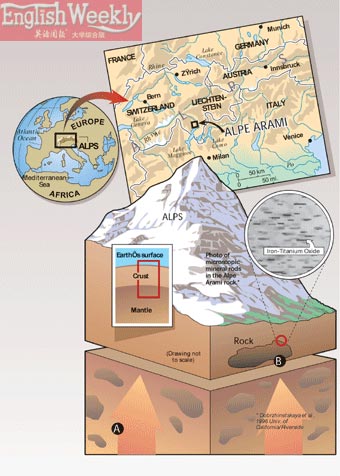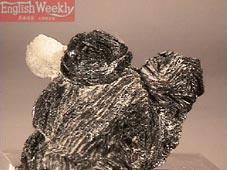
|
|
|
|
What’s under the Swiss Alps?http://www.sina.com.cn
2007年02月07日 03:01 英语周报大学版
 What’s under the Swiss Alps?  What’s under the Swiss Alps? What’s under the Swiss Alps? (2006-2007学年第18期) In 1996 researchers found a massive chunk of rock in an area of the Alps called Alpe Arami that apparently rose to the surface tens of millions of years ago from deeper beneath the earth than ever before. The rock is 2,500 feet (762 meters) by 1,500 feet (457 meters) and made up largely of the mineral olivine. By examining tiny crystals containing iron and titanium oxide, scientists concluded that the structure could have been formed only at great temperatures and pressures. To experience those temperatures and pressures, the rock had to have been at least 180 miles (289 kilometers) beneath the surface and possibly as deep as 300 miles (482 kilometers). When the continental plates of Africa and Europe collided, some of the lighter surface rock was carried deep into the Earth’s crust by heavier rocks. As the heavier rocks warmed and then melted, the lighter rock began rising to the surface, carrying with it small pieces of heavier mantle rock. That’s what the scientists believe they found in the Alps. Mantle rocks from about 60 miles beneath the surface have been found in the Italian Alps, China, Kazakhstan(哈萨克斯坦共和国) and western Norway. THE MINERAL ILMENITE Chemical Formula化学分子式: FeTiO3, Iron Titanium Oxide Class 种类: Oxides and Hydroxides5 Group 族: Hematite6 Subgroup 亚层[类]: Ilmenite Uses 用途: As the major ore of titanium, a minor ore of iron, as a flux in blast furnaces, as an abrasive and as mineral specimens. Ilmenite is an economically important and interesting mineral. It is named for its place of discovery, such places are called type localities, at Ilmen Lake in the Ilmen Mountains, Miask in the southern portion of the Ural Mountains(乌拉尔山脉) of Russia. Ilmenite forms as a primary mineral in mafic igneous rocks(铁镁质火成岩) and is concentrated into layers by a process called“magmatic segregation”(岩浆分结酌). It crystallizes out of a magma relatively early before most of the other minerals. As a result, the heavier crystals of ilmenite fall to the bottom of the magma chamber(岩浆房) and collect in layers. It is these layers that constitute a rich ore body for titanium miners. Ilmenite also occurs in pegmatites(花岗伟晶岩) and some metamorphic rocks(变质岩) as well as in the sedimentary rocks that are formed from the weathering and erosion of them. Since its discovery, the mineral ilmenite has grown greatly in its importance. It is now the most important ore of titanium. Titanium was at one time a metal that had little use and basically no one knew what to do with it. Even as late as 1946 when the metal was finally shown to be capable of being produced commercially, it was considered a “laboratory curiosity. ”Since that time, titanium has been shown to be a strong aluminum-like metal; light weight, non-corrosive, able to withstand temperature extremes (especially its high melting point, 1800 degrees C) and it has good strength (as strong as steel and twice as strong as aluminum). Titanium alloys have found many applications in high tech airplanes, missiles, space vehicles and even in surgical implants.
【发表评论】
|
